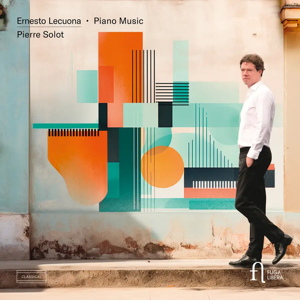
Ernesto Lecuona (1895-1963)
Piano Music
Pierre Solot (piano)
rec. 2023, Salle Philharmonique, Liège, Belgium
Fuga Libera FUG829 [63]
Ernesto Lecuona’s name was once more widely known than perhaps it is today; his Malagueña was once widely performed and his song Always in my heart was nominated for best original song at the 15th Academy Awards in 1943, losing out to White Christmas. He was born in a township of Havana and took his first lessons with his sister Ernestina, a talented pianist and composer who would sometimes play four hands piano with her brother on his professional tours. These tours took him all over Europe and the Americas and introduced him to the likes of Ravel and Gershwin – indeed Lecuona became known as the Cuban Gershwin. Apart from his many piano works he wrote songs, zarzuelas and film scores.
The pieces chosen here fall into two general groups; those based on Cuban songs, dances and rhythms and those that echo a more European style of piano miniature. Most obviously in the former category are the set of ten Cuban Dances whilst works like Bellflower and the several waltzes could have been born in a European salon. One such opens the disc; Aragón, a virtuosic concert waltz with a cadenza like introduction and occasional hints of Tchaikowsky, admirably dazzling in Solot’s hands. Lecuona was fond of waltzes and others appear in this recital. Rococo and Vals Azul are from a set of three waltzes; Rococo doesn’t emulate the music of the French clavecinists but rather the rococo’s florid, decorated style, especially in the faster middle section. It could have come from the pen of Franz Léhar as could its companion with its rippling accompaniment. Vals de las sombras, his shadow waltz is more about Cuba, with a seductive and passionate sophistication that is richer in the version recorded here than the more straightforward version published as one of six waltzes in 1918.
Before we leave this side of the Atlantic we have the Mazurka glissando which is exactly what it says on the tin, a light-hearted salon mazurka chock full of glissandi while his tres miniatures contain the aforementioned Bellflower, a piece that would fit nicely amongst Billy Mayerl’s In My Garden collections. Music Box is a fleet scherzo that has a little of Abram Chasin’s Rush hour in Hong Kong about it and Polichinelle’s dance is energetic, full of scale passages and jaunty rhythms. Neither the booklet nor Solot’s notes mention that several works here belong in sets. Thus Canción de luna and Merry-go-round whirl are from his estampas infantiles – childrens’ prints or sketches, his Danzas afro-cubanas contain Danza lucumi and La Comparsa and two numbers, Malagueña and Gitanerias, are taken from the suite Andaluza. Canción de luna, song of the moon, is a warm hearted song without words and merry-go-round is a moto perpetuo that delights in bouncing from key to key with abandon.
Back in Cuba, by way of these Children’s pieces, Solot places Lecuona’s 19th Century Cuban Dances at the heart of the recital. They are more properly titled Cuban Dances in 19th Century style and remind me of the writing of Louis Moreau Gottschalk who spent a lot of time in Cuba and popularised the music of the island and of Latin America in his piano works. Characteristics of habañera rhythm are present in many of these colourful and energetic pieces. Colour and passion are present in abundance in his familiar Malagueña but his sparkling Gitanerias with its whirlwind evocation of gypsy music deserves to be better known. His Danza lucumi is named for the language of many Cubans that has its origins in West Africa and, like its companion the processional La Comparsa it begins quietly and gradually gains in volume like a street carnival parade approaching and passing in all its splendour before fading into the distance.
Lecuona’s sentimental side, epitomised by his song Always in my heart, is reflected in the tender Yo te quiero siempre, I will always love you. Emotionally deeper is the monumental Ante el Escorial, before the Escorial, the 16th century royal monastery, its grandeur depicted in the chordal opening, passionate main theme and virtuoso figuration. In similar mood a second architectural picture vividly portrays San Francisco el grande, the royal basilica in Madrid. Its opening chords are bell like and are joined by chorale writing then, like Liszt, Lecuona lets his passions run high at the sheer spectacle before him. That just leaves my favourite discovery here, the nocturnal Preludio en la noche with its modal harmony and rather sentimental melody.
Details of the music played may be sketchy but that is no obstacle to the enjoyment of this varied and illuminating recital by Brussels born pianist Pierre Solot.
Rob Challinor
Buying this recording via a link below generates revenue for MWI, which helps the site remain free.



Contents
Aragón
Preludio en la noche
Malagueña (1933)
Rococo
Vals Azul
Ante el Escorial
Danza lucumi
Yo te quiero siempre
19th Century Cuban Dances
La Comparsa
Vals de la sombras
Gitanerias
Canción de luna
Merry-go-round whirl
Mazurka glissando
Tres Miniatures
San Francisco el grande

















